Dr Trust Goldline Digital BP Monitor 103 Instruction Manual
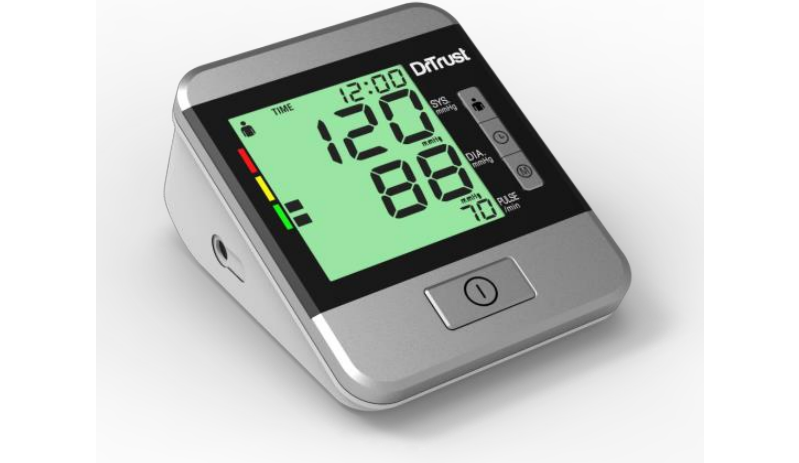
Content
Introduction
The Dr. Trust Goldline Digital BP Monitor 103 is a state-of-the-art blood pressure monitoring device designed for ease of use and accuracy. Manufactured by Nureca Limited, this monitor features dual talking capabilities in Hindi and English, along with a three-color backlit hypertension indicator for clear readings. Launched in 2023, the product is priced at approximately $48. It also includes advanced features such as arrhythmia detection and memory storage for two users, ensuring comprehensive health monitoring.
Components of your Monitor

Display
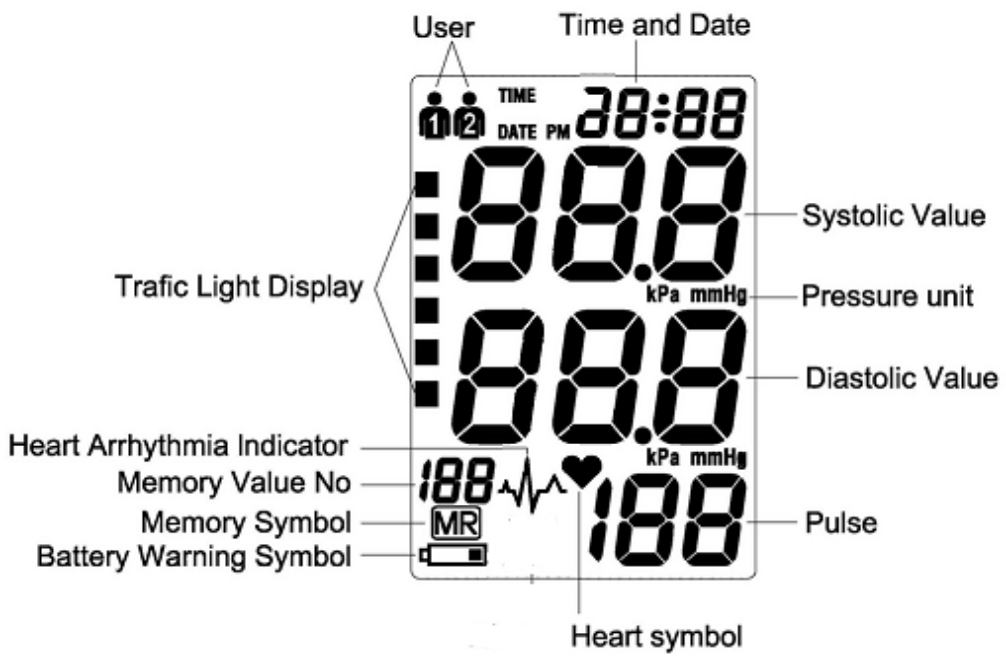
Technical specifications
Measurement Procedure: Oscillometric, corresponding to Korotkoff method: Phase I (systolic), Phase V (diastolic)
Display:
- Digital display
Measuring Range:
Pressure: 30 to 280 mmHg (in 1 mmHg increment)
Pulse: 40 to 200 beat/minute
Static Accuracy:
Pressure: ±3 mmHg
Pulse: ±5% of reading
Measuring Resolution: 1 mmHg
Inflation: Automatic inflation by internal pump
Memory Function: 2 x 120 memories for 2 users (SYS, DIA, Pulse)
Decompression: Constant exhaust valve system
Power Source: 4-size "AA" alkaline batteries
Rated Voltage: DC 6.0V, 4.0W (direct current)
Operation Temperature: 540°C / 41104°F
Operation Humidity: 15%–85% RH maximum
Storage Temperature: -20~60°C / 14–131°F
Storage Humidity: 15%–95% RH maximum
Dimensions: 136 x 113 x 65 ±1.0 mm
Weight: 505 g ±5 g (including batteries and cuff)
Cuff Pressure Display Range: 0~299 mmHg / 0–39.9 kPa
Electrical Shock Protection: Internal power unit
Safety Classifications: Type B equipment
Mode of Operation: Continuous operation
Protection Against Ingress of Water: IP22
Accessories: M-L-size Cuff, 4 "AA" batteries, instruction manual
Notice: Adapter must comply with EN60601-1, EN60601-1-2
Description
The Dr. Trust Goldline Digital BP Monitor 103 boasts a sleek and compact design, making it easy to store and transport. It comes with a comfortable cuff that fits arm sizes ranging from 8.7 to 16.5 inches, ensuring a snug and accurate fit for most users. The device operates on 4 AA batteries, which are included in the package. It also features a built-in irregular heartbeat detector and alerts for high blood pressure readings.
The monitor includes a detailed user manual and comes with a carry case for convenience. The large LCD display shows systolic, diastolic, and pulse readings clearly, and it has a backlit screen for easy reading in low-light conditions.
Important information about self-measurement
- Substitution of a different component might result in measurement error.
- Cuff is replaceable only by an original.
- Do not use on neonatal patients.
- Do not intend to use on pregnant or pre-eclamptic patients
- Keep Product in proper packing. Any wrong use will cause harmful injury to the patient or affect the blood pressure.
- Too frequent measurements can cause injury to the patient due to blood flow interference. The application of the cuff over a wound can cause further injury.
- The application of the cuff and its pressurization on any limb where intravascular access or therapy, or an arteriovenous (A-V) shunt is present because of temporary interference to blood flow and could result in injury to the patient.
- Do not let the cuff and its pressurization on the arm on the side of a mastectomy Pressurization of the cuff can temporarily cause loss of function if simultaneously used monitoring ME equipment on the same limb.
- Please check that operation of the automated sphygmomanometer does not result in prolonged impairment of patient blood circulation.
- Not intended to be used together with HF surgical equipment.
- Do not forget: self-measurement means control, not diagnosis or treatment. Unusual values must always be discussed with your doctor. Under no circumstances should you alter the dosages of any drugs prescribed by your doctor.
- The pulse display is not suitable for checking the frequency of heart pacemakers!
- In cases of cardiac irregularity (Arrhythmia), measurements made with this instrument should only be evaluated after consultation with the doctor.
Electromagnetic interference
The device contains sensitive electronic components (Microcomputer). Therefore, avoid strong electrical or electromagnetic fields in the direct vicinity of the device (e.g. mobile telephones, microwave cookers). These can lead to temporary impairment of the measuring accuracy.
Important information on the subject of blood-pressure and its measurement
How does highnow blood-pressure arise?
As your heart beats, ii pumps your blood round your body so that your muscles can gel all the energy and oxygen they need. To do this, your heart pushes your blood through a network of blood vessels called arteries. As the blood travels through the arteries it pushes against the sides of these blood vessels and the strength of this pushing is called your blood pressure.
As your heart squeezes and pushes your blood through your arteries, your blood pressure goes up. As your heart relaxes, your blood pressure goes down. So, with each heartbeat, your blood pressure will rise to a maximum level and then fall to a minimum level.
Which values are normal?
Blood pressure is too high if at rest, the diastolic pressure is above 90 mmHg and/or the systolic blood-pressure is over 160 mmHg. In this case, please consult your doctor immediately. Long-term values at this level endanger your health due to the associated advancing damage to the blood vessels in your body.
Should the systolic blood-pressure values lie between 140 mmHg and 160 mm Hg and/or the diastolic blood-pressure values lie between 90 mm Hg and 100 mm Hg, likewise, please consult your doctor. With blood-pressure values that are too low, i.e. systolic values under 100 mm Hg and/or diastolic values under 60 mmHg, likewise, please consult your doctor. Even with nonmal blood-pressure values, a regular self-check of your blood-pressure is recommended. In this way you can detect possible changes in your values early and react appropriately.
If you are undergoing medical treatment to control your blood pressure, please keep a record of the level of your blood pressure by carrying out regular self-measurements at specific times of the day. Show these values to your doctor. Never use the results of your measurements to alter independently the drug doses prescribed by your doctor.
Table for classifying blood-pressure values (unit: mm Hg) according to World Health Organization:
Operation
Inserting the batteries
- Insert the batteries (4 x size M 1.5V). thereby observing the indicated polarity.
- If the battery power reduces less than 20%. battery warning
 icon appears.
icon appears. - If the batteries are empty. battery warning
 icon appears indicating immediate replacement by new ones.
icon appears indicating immediate replacement by new ones.
Attention!
After the battery warning ![]() icon appears. the device is blocked until the batteries have been replaced.
icon appears. the device is blocked until the batteries have been replaced.
- Please use «AA» Long-Life or Alkaline1 .5V Batteries.
- Please remove the batteries from the device. if the blood-pressure monitor is left unused for long periods.
User Selection
This advanced blood pressure monitor allows you to track blood pressure readings for 2 individuals independently:-
- Before measurement. make sure you set the user no. for the intended user. The unit can track results for 2 individuals (User 1. User 2).
- Press the TIME button for atleast 3 seconds. The display now indicates the set user. To confirm. press ON/OFF button.
- Click the MEMORY button to select User 2.
- We suggest the first person to take their pressure to be User 1.
Language selection & Time/ Date setting
Language Selection
User can select either of the two languages i.e. English & Hindi. if talking required. Else user can mute the unit.
- Press & hold On/Off button for 3 seconds. Default Language 1 (Language English) will appear.
- To change language to Language 2 (Hindi), press memory button one time. Press this button twice to mute. To go back to English press setting button.
Setting the time, date
This blood-pressure monitor incorporates an integrated clock with date display. This has the advantage, that at each measurement procedure, not only the blood-pressure values are stored, but also the exact moment of the measurement. After new batteries have been inserted, the clock begins lo run from the following setting: 2010-06-20 09:30 o'clock. You must then re-enter the date and current lime. For this, please proceed as follows.
- Press the TIME button for at least 3 seconds firstly, user icon will blink. Then press TIME button again, the display now indicates the set year, during which the four characters blink.
- The correct year can be entered by pressing the MEMORY button
- Press the TIME button again. The display now switches to the current date, during which the first character (month) blinks.
- The corresponding month can now be entered by pressing the MEMORY button.
- Press the TIME button again. The last two characters (day) are now blinking
- The corresponding day can now be entered by pressing the MEMORY button.
- Press the TIME button again. The display now switches to the current lime, during which the first character (Hour) blinks
- The corresponding hour can now be entered by pressing the MEMORY button.
- Press the TIME button again. The last two characters (Minutes) now blink.
- The exact lime can now be entered by pressing the MEMORY button
- Press TIME button (or TIME/ DATE or TIME): the unit of measurement will flash.
- Press the "MEMORY to set the unit of measurement (mmHg or kPa)
- Once you have done the settings, press the TIME button (or TIME/ DATE or TIME). The setting is confirmed and the clock starts running.
- Now after all settings have been made, press the TIME button once again. The date is briefly displayed and then the time. The input is now confirmed and the clock begins to run.
Further Information
With each press of the button (TIME, MEMORY) one input is made (e.g. switching over from hours to minutes mode, or altering the value by +1). However, if you keep the respective button depressed, you can switch more quickly to find the desired value.
Carrying out a measurement
Before the measurement
- Avoid eating, smoking as well as all forms of exertion before the measurement. All these factors influence the measurement result. Try and find time to relax by sitting in an armchair in a quiet atmosphere for about ten minutes before the measurement.
- Measure always on the same arm (normally left).
- Attempt lo carry out the measurements regularly at the same time of day, since the blood -pressure changes during the course of the day.
Common sources of error
Note: Comparable blood-pressure measurements always require the same conditions! These are normally always quiet conditions.
- All efforts by the patient to support the arm can increase the blood-pressure. Make sure you are in a comfortable, relaxed position and do not activate any of the muscles in the measurement arm during the measurement. Use a cushion for support if necessary.
- The performance of the automated sphygmomanometer can be affecled by extremes of temperature, humidity and altitude.
- Avoid compression or restriction of the connection tubing.
- A loose cuff causes false measurement values.
Filling the cuff
Insert air connector into air outlet shown in left photo and please make sure the fitting of the air connector is tight completely and proper to avoid air leakage.
- The distance between the edge of cuff and the elbow should be approx. 2~3cm.
- Secure the cuff with the Velcro fastener, so that ii lies comfortably and not too light, whereby no space should remain between the cuff and the arm.
- Lay the arm on a table, with the palm upwards. Support the arm a little with a rest (cushion), so that the cuff rests at about the same height as the heart. Take care, that the cuff lies free. Remain so for 2 minutes sitting quietly, before beginning with the measurement.
Let legs uncrossed, feel flat on the floor, back and arm supported.
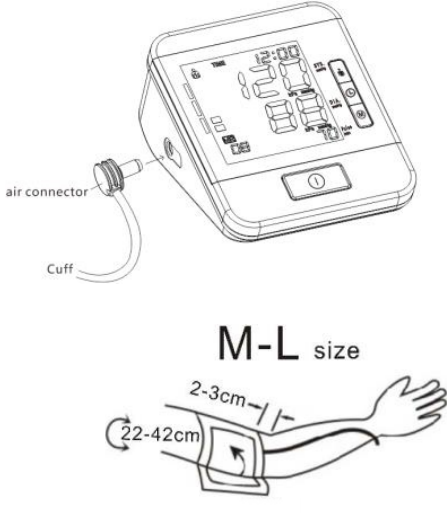
Measuring procedure
After the cuff has been appropriately positioned, the measurement can begin:
Press the ON/OFF button, the pump begins to inflate the cuff. In the display, the increasing cuff-pressure is continually displayed.

After reaching the inflation pressure, the pump stops and the pressure slowly falls away. The cuff-pressure (large characters) is displayed during the measurement. When the device has detected the pulse, the heart symbol in the display begins to blink for every pulse beat. The measured systolic and diastolic blood -pressure values as well as the pulse frequency are now displayed.
Example (Fig.): Systole 118, Diastole 73, Pulse 75
The measurement results are displayed, until you switch the device off. If no button is pressed for 3 minutes, the device switches automatically off, to save the batteries. P Monitor 103,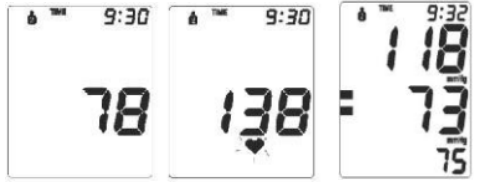
- Start by ensuring the batteries are properly inserted.
- Next, place the cuff around your upper arm, making sure it is not too tight or too loose.
- Press the power button to turn on the device. The monitor will automatically inflate the cuff; wait until it deflates to get your reading.
- For assembly, simply attach the cuff to the main unit using the provided connector.
- Configuration is minimal as the device is ready to use out of the box.
- For pairing with other devices, this model does not support Bluetooth or Wi-Fi connectivity but can be used independently.
Discontinuing a measurement
If ii is necessary to interrupt a blood pressure measurement for any reason (e.g. the patient feels unwell), the "ON/OFF" power button can be pressed at any time. The device then immediately lowers the cuff-pressure automatically.
Memory - storage and recall of the measurements
The blood-pressure monitor automatically stores each of the last 120 measurement values. By pressing the MEMORY button, an average value of the last 3 measurements as well as the last measurement and the further last 120 measurements (MR 119,MR118 ... ,MR1 )can be displayed one after the other (MR1: Values of the last measurement) (MR2-MR120: Values of the measurement before MR1)

Pay attention that the maximum memory capacity is not exceeded. When the memory is full, the old values are automatically overwritten with new ones.
Memory- cancellation of all measurements!
Before you delete all readings stored in the memory, make sure you will not need to refer to the readings at a later date. Keeping a written record is prudent and may provide additional infonmation for your doctor's visit. In order to delete all stored readings, press the MEMORY button for at least 5 seconds, the display will show the symbol «CL» and then release the button. To permanently clear the memory, Press the MEMORY button while «CL» is flashing.

Appearance of the Heart Arrhythmia Indicator for early Detection
This symbol .); indicates that certain pulse irregularities were detected during the measurement. In this case, the result may deviate from your nonmal blood pressure - repeat the measurement. In most cases, this is no cause for concern. However, if the symbol appears on a regular basis (e.g. several times a week with measurements taken daily) we advise you to tell your doctor.
Care and Maintenance, Recalibration
- Do not expose the device lo extreme temperatures, humidity, dust or direct sunlight.
- The cuff contains a sensitive air-light bubble. Handle this carefully and avoid all types of straining through twisting or buckling.
- Clean the device with a soft, dry cloth. Do not use petrol, thinners or similar solvent. Spots on the cuff can be removed carefully with a damp cloth and soap. The cuff must not be washed!
- Do not drop the instrument or treat it roughly in any way. Avoid strong vibrations.
Never open the device! Otherwise the manufacturer calibration becomes invalid!
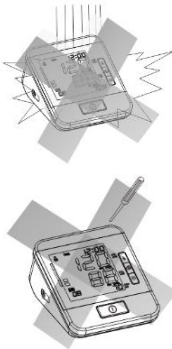
Battery life
800 limes measurement with 4- size "AA" alkaline Batteries.
Troubleshooting
If an error occurs during a measurement, the measurement is discontinued and a corresponding error code is displayed.
Error No. | Possible cause(s) |
ERR1 | No pulse has been detected. |
ERR2 | Unnatural pressure impulses influence the measurement result. Reason: The arm
was moved during the Measurement (Artifact). |
ERR3 | The inflation of the cuff takes too long. The cuff is not correctly seated. |
ERR5
ERRB | The measured readings indicated an unacceptable difference between systolic and diastolic pressures. Take another reading following direction carefully. Contact you doctor if you continue to get unusual readings. Pressure in cuff is over 290mmHg |
Further Information
The level of blood-pressure is subject lo fluctuations even with healthy people. Important thereby is, that comparable measurements always require the same conditions (Quiet conditions)! If, in spite of observing all these factors, the fluctuations are larger than 15mmHg, and/or you hear irregular puls e tones on several occasions, please consult your doctor. For licensing, the device has been subjected to strict clinical tests, by which the computer program used to measure the blood-pressure values was tested by experienced specialist doctors in Germany.
The same computer program is used in every individual device, and has thus also been clinically tested. The manufacture of the devices takes place according to the tenms of the European standard for blood-pressure measuring devices (see technical data) you must consult your specialist dealer or chemist if there are technical problems with the blood-pressure instrument. Never attempt to repair the instrument yourself!
Any unauthorized opening of the instrument invalidates all guarantee claims!
Other possible malfunctions and their elimination
If problems occur when using the device, the following points should be checked and if necessary, the corresponding measures are to be taken:
The display remains empty when the instrument is switched on although the batteries are in place. |
|
The device frequently fails to measure the blood pressure values, or the values measured are too low (too high). |
|
Every measurement produces a different value although the instrument functions normally and the values displayed are normal | 1. Please read the following information and the points listed under
«Common sources of error». Repeat the measurement.
Please note: Blood pressure fluctuates continually so successive measurements will show some variabiltiy. |
Blood pressure measured differs from those values measured by the doctor. | 1. Recordthe daily developmentof the values and consult your doctor. Please note: Individuals visiting their doctor frequently experience anxietywhich can resultin a higher reading at the doctor than obtained at home under resting conditions. |
Pros & Cons
Pros
- Accurate Readings: The Dr. Trust Goldline Digital BP Monitor 103 is known for its accuracy and reliability.
- Easy to Use: The intuitive interface makes it simple for anyone to operate.
- Affordable: Priced competitively, making it accessible to a wide range of users.
- Memory Storage: Stores up to 120 readings, helping you track your blood pressure over time.
- Portable: Compact design with a carry case for easy transport.
Cons
- No Bluetooth or Wi-Fi Connectivity: Cannot pair with smartphones or other devices for data transfer.
- Battery Life: Requires frequent battery replacements if used frequently.
- Cuff Size Limitations: May not fit very large or very small arms comfortably.
Customer Reviews
Customers have generally praised the Dr. Trust Goldline Digital BP Monitor 103 for its ease of use and accuracy. Many have found it helpful in monitoring their blood pressure regularly. However, some users have noted that the cuff can sometimes be a bit stiff and that battery life could be better.
Common complaints
Include issues with the cuff fitting larger or smaller arms and occasional inaccuracies if not used correctly.
Faqs
How do I ensure accurate readings with the Digital BP Monitor 103?
Can I use the Dr. Trust Goldline on both arms?
How often should I replace the batteries in the Dr. Trust?
Is the Dr. Trust Goldline suitable for children and infants?
How many readings can I store on the Dr. Trust Goldline Digital BP Monitor 103?
Does the BP Monitor 103 come with a warranty?
How do I know if my blood pressure reading is normal or abnormal using the Dr. Trust Goldline Digital BP Monitor 103?
Leave a Comment
